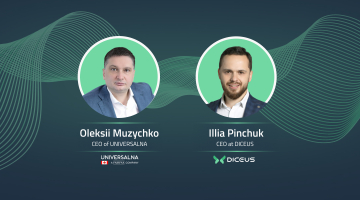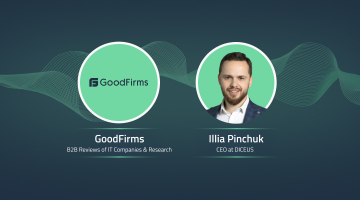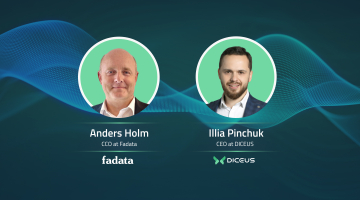
Interview with a former CEO of Willis Nordics: How technology impacts insurance
Poul Orum joined the insurance industry more than 30 years ago. He worked as a CEO/Leading Partner at Willis Nordics for 19 years before starting his own company RiskVille, which supplies IT solutions to the insurance world.
Illia Pinchuk, the DICEUS CEO, recently spoke with Poul about the challenges of handling the insurance business and the importance of implementing appropriate software. Poul talked about his tremendous experience in changing the industry with new models and software systems, in general, and the implementation of the premium calculator and risk management, in particular.
The following conversation will be interesting to insurers who want to grow their business with the help of technology. Here you will learn what impact the right software has and what benefits it brings to the table.

Q: Poul, as I know, you spent much of your career working as a Leading Partner at Willis Nordics. Please tell us a little bit about your experience at the company.
A: I think I have worked for 19 years at Willis. Before that, I worked at another broker business. When I joined Willis, it was a local entity, but we needed some international networks. So, we tried to go into some of these networks, and every time we connected to a network, it was bought by one of the big international brokers. We concluded that if we should go worldwide, we had to be in an international network that was more stable.
We found out that Willis had a small subsidiary in Copenhagen. Then, we asked Willis whether they were willing to sell this subsidiary and offered to buy the entity and then change our name to Willis. They could have a stake in our company. Of course, it took some time, but they grasped the idea. They had been losing money on their subsidiary, and they saw that our offer could give them growth potential. So, we bought it, and then, they bought us — not all our shares, but they had an option to take the rest of them.
And we started growing. That was a very nice journey. However, I’ve had conversations with the insurance business for a long time before, and one of my goals for going into Willis was to reform the business a little. The business was old and dusty and had to be more efficient. The costs were too high due to the lack of just simple systems. This is actually what we did at Willis, by combining good training of people and developing good IT systems.
Q: You said that one of the challenges you faced was that the business was old and it should be renovated with new systems. What kind of other challenges did you face while working at the company?
A: Of course, when you work in a business, and you are not from it, people will always look at you quite skeptically because they don’t know what to expect. And this was actually very good because they knew we were coming up with something new. I would say this was not only me. That was the spirit of the company.
We were owners together, a lot of owners. When I started, there were maybe 15 or 16 owners. And when I stopped, we were 60 owners out of 500 people at the company. This collective ownership really meant something. People were getting out of their way to do something special. So, it was not only me working this way, trying to change the industry that has been used to meetings, drinking coffee, and discussing prices. We were trying to break that up and get some competition into the market.
That was quite something to do. And we had to have some kind of leverage. And this leverage we could acquire by going outside of Denmark and trying to get some insurance companies to grow through the market. However, they didn’t have the means to set up their operations. So, we had to be able to help them set up the operations inside of Willis with Willis tools.
This gave us some challenges: how to make the administration run, collect premiums, etc. And when the industry found out what was happening, they started lobbying for the Danish insurance law to be changed. That’s because when we started, we used the English model — the broker gets a commission from the insurance company, which is embedded into the premium.
The insurance industry thought that if they turned this into a system where the premium ought to be a premium, and the brokers’ fee should also be shown and be built separately, they would make us less popular in the markets. And they actually did after a few years. They managed to do that. The banking and insurance industry is quite strong in Denmark, and most banks and insurance companies rely on each other. So, they acted together and managed to get that.
And it’s something in the broker industry called the Danish sickness. It started in Denmark, and it’s slowly spreading through. First, t went to Scandinavia and now it’s spreading across Europe. The broker should not be able to get any commission from an insurance company. They should only be representing their customers and not any insurance companies.
So, we saw that they were trying to do this, and we put our heads together and said, “What will we do about this?” So then, we decided if you can’t beat them, join them. That’s a popular saying in Denmark. So, we said this new law would be in effect in a couple of years, but we could do it now.
And we started changing our ways and our selling to be on a net basis. In that way, the effect was positive. The other brokers were reluctant; they wanted to stay in the old way of doing things. So, in these two years, we took half of the market because customers reacted positively to us, being very honest and transparent about what we took for our business, what the cost was, and how the cost was distributed. I think it was something like a mountain to climb but you could. When you were at the top of the mountain, you could certainly see the horizon. So, it was a nice journey.
Q: Did that change the insurance model and work of brokers? Has that led to the implementation of some software or technology?
A: Yes. All systems had to be changed. We had to go from the old system where we sent all the premiums to the insurance company, and afterward, they paid us. And now we had to collect the premiums, put our fee on top, send it to the customer, collect the cost and then distribute the premium back to the insurance company. And that really meant that we had to change all of our systems. We had to do it quickly.
Q: And what kind of software systems have you implemented? What technologies did you use?
A: We had two kinds of systems or two parts of the system. One system should convey how the money flowed through our company because the flows were different, and how we handled it was different. The way that we should split these flows was quite new. We had a standard accounting system used for putting out and controlling invoices, but we had to rebuild and rethink it. So, we looked at the flows and then made a system according to those flows, and we did this system ourselves. We used some standard software called FoxPro as a database. We had a very clever guy, the architect of the system, who decided that we should go purely to Microsoft. So, we used .NET mainly and some other minor systems. .NET programming made it possible for us to do this quickly.
Q: What were the main functionalities these software solutions had?
A: When you look at what you do for the customer, you assess their risks. You find out what risks are covered and what risks are not covered. Then, you depict this in an insurance policy and go to the market. You tender out the coverage and see what the different insurance companies are willing to cover and the price they will take.
Then, you go back to the customer and tell him the best coverage he can have regarding what claims he had and what risks he actually has. So, we also had to invent a system where we recorded all the claims.
Relying on what the insurance companies knew and what the customer actually did, we had to invent a system where the customer could file their claims to us. We handled the claims, and that gave us a unique position because we had the information. The guy who has the information is on the hill because we knew what the cost should be. Since I studied actuary mathematics, I know it’s impossible to get in the long run an insurance that is cheaper than your amount of claims. So, you can look at that, calculate, find out what the natural premium should be, and compare it to what the customer is paying for.
And then you can give this advice to the customer, saying some of the things you can do, for example, that “you can save some premium, but now you are very close to your natural premium. So, we should also work with what is actually costing you money. And that is the claims and the cost of handling these events.” We simultaneously started a business, helping the customers prevent claims ei. Helping them to avoid fires, thefts, liabilities or people getting stressed.
So, we analyzed and found out what was actually happening. Why do they get these claims? We had an example in the hospitals. They had problems with the injection syringes. When people were washing the doctors’ clothes, they got hurt because the doctors put the old instruments in their pockets. These injection syringes and other small instruments went to the washing machines. Then, the people who worked with that got hurt, and actually, some of them got HIV because a lot of the instruments were polluted by bad blood since there’s a lot of blood in the hospitals.
So, we’ve tried to analyze why this was happening. It’s impossible to teach doctors that they should not put something in their pockets. So, the real thing is to give them some clothes without pockets. Then, they will put the instruments somewhere else.
This was the way we introduced Risk Management. It was quite new. Of course, there’s always been some risk management, but risk management of that kind was new to the market. We could do that because we invented a system where people could log online, sign in to their profiles, and submit any claim. And it was very easy. It was easier than using the old-fashioned scheme where you had to have a pen and paper and answer many irrelevant questions. So, we actually made a responsive system. You answer these questions when it is needed only.
People wanted to use our system because it took them less time. Everybody could find out something should be done about it, but you also had to have the tool. The tool was a good system where we could integrate claims, insurance costs, tendering, etc.
Q: How did this new software impact the customers?
A: Well, this is a great question. I think the customers were, of course, happy because what we were able to deliver was that we could decrease the total cost of having their business in terms of risk.
So, when they look at the risk (and if you are making shoes and selling them, there will always be some natural risk that you cannot be without), we can assure them that they are paying the lowest cost possible.
And, of course, this was a unique selling point. So, we could go to a customer and say we could analyze your company. We can analyze whatever you do. And if you allow us to be a broker, we will help you reduce the total cost in a way you will accept. Then, we told them you would have to see that the cost for the broker would go up but the cost of your risk would go down even more, and they accepted this.
They were positive. And it was quite easy getting new customers. The other thing we said to them was, “you have a lot of administration on your own hands, and often, you had to do that. If you own a lot of buildings or admin a lot of buildings, you have a lot of people sitting there and doing a lot of jobs. We can take some of these jobs related to risk and insurance because we have to do them anyway and we can integrate them into our system.” We also said to them: “If we take over your insurance department, we can also take over your people. You don’t have to monitor them, they will do a good job, and they will get more experience and a lot of knowledge, so they will have more fun working, and you will be able to reduce your costs.”
It’s still a good way of doing things, but you are never alone for a long time. So, our competitors will have taken up a lot of this, but what is happening in the Danish market is that the big international competitors are not able to do it because they’re not able to convince the home base that they should have new or improved IT systems. So, they are not able to do what they should do without using a lot of manpower. And if you have to use a lot of manpower, you wouldn’t be competitive.
In that way, we could keep ahead of the big competitors. But, of course, some of the minor competitors can go in and say, “you have been with Willis for ten years. They have leaned your how to manage your insurance. They have leaned your chain of risk, etc. But they have taken a lot of money for doing that. Now we can do it for half of the money.” And some clients respond to that. So, you’ll never be alone. The only way true is to be in front, faster, and more efficient. And the only way to do that is to do it by building better systems.
Q: By the way, were there any technological challenges while implementing the software?
A: Yes. But these challenges were self-made. After some time, in 2010, the global Willis company cited their rights to buy 100% of the company. We had to accept that the international IT organization of Willis took over, and they didn’t want any cloud solutions.
Well, there were hardly any cloud solutions. They were behind and lacked the knowledge of what actually was happening. They were more about good security and the system should be running and changing passwords. So, we had a problem of being too much in front, running in front of a big corporate company.
Q: Did you face any obstacles in achieving your project goals? And could you please some failures of the project you dealt with?
A: Yes, of course, we’ve faced many obstacles. We were very client-driven, and our mistake was putting too many salespersons at the head of development. Sale managers are constantly reacting to every customer’s requirement. I think we should have had better filters on that because we had a problem in a few years. A kind of fight started between what people wanted and what people delivered.
That decision was counterproductive. I think we should have it both ways, and we should have taken IT problem and management as a real problem. We could focus more on IT and IT development.
Q: So, would you approach the project execution differently?
A: For sure.
Q: How would you approach the project?
A: I think I would plan a short option. I also think the management should always be in for the plans for the developing systems in the company because there has to be somebody thinking long term. Otherwise, you’ll have a lot of setbacks in your development. The executive Board should be deeply involved.
Q: In your opinion, what are the top three digital solutions insurance companies should have today?
A: Well, it’s difficult for me without considering my own company RiskVille. And I think any insurance company should have a good platform able to communicate. And that’s the main problem, at least in the European market today. Insurance companies are mainly islands. They have some cheap selling, but they’re not really integrated and communicating. So, I think people working with insurance companies should think about how to integrate the systems. It’s about getting the customers into apps and online shops, etc. The traffic is too low because the insurance company is not just an insurance company. Most insurance companies really don’t take all of the risk. They take some of the risks, but they sell the risk to the next insurance company, and this insurance company sells the risk again.
So, you have maybe 1% of the risk in this company and 2% in another company. And this is the way insurance actually runs because otherwise, if you, as an insurance company, took all the risk, there would be a big claim. Then you will go bankrupt. So, you have to do this to distribute the risk, and that’s the nature of insurance.
However, to distribute, you have to be distributed. You cannot be an island and work with paper. If you go through Lloyd’s market (the biggest market for trading and slowly changing), but still they go down with small pieces of paper and say, I have this ship; it’s 1 billion pounds. How many of these would you want?
And the underwriter says, “oh, okay, I’ll take 15%. And then he writes on the slip, and that’s how it’s done. And this is absolutely inefficient. And the only way this can happen is because the insurance company and the brokers have supernormal earnings. They earn too much, and thus, they become lazy. Of course, this is a very critical presentation, but the industry needs to develop new and integrated systems.





